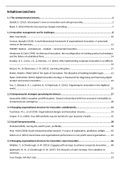Lecture 3 (BOOK) – Bioenergetics
and metabolism II (Thunnissen)
Chapter 2: page 73-88 and panels 2.8 and 2.9
CH2 Cell Chemistry and Bioenergetics
How Cells Obtain Energy from Food
The energy suppler tat cell sneed comes from the chemical-bond energy in food molecules.
Enzymatic digestion breaks down the large polymeric molecules in food into their monomer subunits.
Glycolysis
Glycolysis is the major process for oxidising sugars. Glycolysis happens in the cytosol and produces
ATP without the involvement of O2. During glycolysis a 6 carbon glucose molecule is converted to
two molecules of pyruvate (3C). For each glucose molecule, two ATP are hydrolysed to provide the
energy for the early steps, but four ATP are produced later, additionally, two molecules of the
activated carrier NADH are also produced. For the detailed glycolytic pathway see PANEL 2-8.
Glycolysis involves a sequence of 10 separate reactions each producing a different sugar
intermediate and each catalysed by a different enzyme. The enzyme names end with -ase to indicate
the type of reaction they catalyse.
Some of the energy released by oxidation drives the direct synthesis of ATP molecules from ADP and
Pi, and some remains with the electron in NADH.
Fermentations
In aerobic conditions, glycolysis is just a prelude to the final stage of the breakdown of food
molecules, however in anaerobic conditions glycolysis is the principal source of ATP. In anaerobic
conditions the pyruvate and the NADH electrons stay in the cytosol. The pyruvate is converted into
products excreted from the cell and NADH gives up its electrons and is converted back to NAD+.
Energy-yielding pathways like this, in which organic molecules both donate and accept electrons are
called fermentations.
Enzymes couple oxidation to energy storage
The formation of ATP during glycolysis provides a particularly clear demonstration of how enzymes
couple energetically unfavourable reactions with favourable ones, thereby driving the many chemical
reactions that make life possible. Two central reactions in glycolysis (steps 6 and 7) convert the three-
carbon sugar intermediate glyceraldehyde 3-phosphate (an aldehyde) into 3-phosphoglycerate thus
oxidising an aldehyde group to a carboxylic acid group. The overall reaction releases enough free
energy to convert a molecule of ADP to ATP and to transfer two electrons (and a proton) from the
aldehyde to NAD+ to form NADH, while still liberating enough heat to the environment to make the
overall reaction energetically favourable (∆G° for the overall reaction is –12.5 kJ/mole).
So, ATP can be formed readily from ADP when a reaction intermediate is formed with a phosphate
bond of higher energy than the terminal phosphate bond in ATP.
Food storage in reservoirs
To compensate for long periods of fasting, animals storage fatty acids as fat droplets composed of
water-insoluble triacylglycerols = triglycerides. For shorter-term storage, sugar is stored as glucose
in the polysaccharide glycogen.
Quantitatively, fat is far more important than glycogen as an energy store for animals since it
provides for more efficient storage.
The sugar and ATP needed by plant cells are largely produced in separate organelles:
, - Sugars in chloroplasts
o During periods of excess photosynthetic capacity during the day, chloroplasts
convert some sugars into fat and starch. The fats are the same in animals, but differ
only in the types of fatty acids that predominate.
o Fat and starch are both stored inside the chloroplasts until needed for energy-
yielding oxidation during periods of darkness.
- ATP in mitochondria
o Most of the ATP needed for plant cell metabolism is synthesised in mitochondria and
is than passed to the rest of the cell.
Between meals, most animals derive their energy from fatty acids. While animal readily convert
sugars to fats, they cannot convert fatty acids to sugars, instead, the fatty acids are oxidised directly.
Mitochondria and the citric acid cycle
In aerobic metabolism, the pyruvate procured is transported into the mitochondria of eukaryotic
cells. There it is decarboxylated by the pyruvate dehydrogenase complex. The products are CO2,
NADH and acetyl CoA.
The fatty acids are oxidised in mitochondria as well, and is broken down into one molecule of acetyl
CoA each cycle.
The citric acid cycle is central to the energy metabolism in aerobic organisms. In the citric acid cycle,
the acetyl group in acetyl CoA is oxidised to CO2 and H2O. The citric acid cycle is also called the
tricarboxylic acid cycle or the Krebs cycle.
In the citric acid cycle the acetyl group of acetyl CoA is transferred to oxaloacetate to form citric acid
which is than gradually oxidised allowing the energy of the oxidation to be harnessed to produce
energy-rich activated carrier molecules. In addition to three molecules of NADH, each cycle also
produces one molecule of reduced flavin adenine dinucleotide, FADH2 from FAD and one molecule
of ribonucleoside triphosphate, GTP from GDP.
The energy stored in NADH and FADH2, will be utilised for ATP production through the process of
oxidative phosphorylation which is the only step in oxidative catabolism of foodstuff that directly
requires O2.
and metabolism II (Thunnissen)
Chapter 2: page 73-88 and panels 2.8 and 2.9
CH2 Cell Chemistry and Bioenergetics
How Cells Obtain Energy from Food
The energy suppler tat cell sneed comes from the chemical-bond energy in food molecules.
Enzymatic digestion breaks down the large polymeric molecules in food into their monomer subunits.
Glycolysis
Glycolysis is the major process for oxidising sugars. Glycolysis happens in the cytosol and produces
ATP without the involvement of O2. During glycolysis a 6 carbon glucose molecule is converted to
two molecules of pyruvate (3C). For each glucose molecule, two ATP are hydrolysed to provide the
energy for the early steps, but four ATP are produced later, additionally, two molecules of the
activated carrier NADH are also produced. For the detailed glycolytic pathway see PANEL 2-8.
Glycolysis involves a sequence of 10 separate reactions each producing a different sugar
intermediate and each catalysed by a different enzyme. The enzyme names end with -ase to indicate
the type of reaction they catalyse.
Some of the energy released by oxidation drives the direct synthesis of ATP molecules from ADP and
Pi, and some remains with the electron in NADH.
Fermentations
In aerobic conditions, glycolysis is just a prelude to the final stage of the breakdown of food
molecules, however in anaerobic conditions glycolysis is the principal source of ATP. In anaerobic
conditions the pyruvate and the NADH electrons stay in the cytosol. The pyruvate is converted into
products excreted from the cell and NADH gives up its electrons and is converted back to NAD+.
Energy-yielding pathways like this, in which organic molecules both donate and accept electrons are
called fermentations.
Enzymes couple oxidation to energy storage
The formation of ATP during glycolysis provides a particularly clear demonstration of how enzymes
couple energetically unfavourable reactions with favourable ones, thereby driving the many chemical
reactions that make life possible. Two central reactions in glycolysis (steps 6 and 7) convert the three-
carbon sugar intermediate glyceraldehyde 3-phosphate (an aldehyde) into 3-phosphoglycerate thus
oxidising an aldehyde group to a carboxylic acid group. The overall reaction releases enough free
energy to convert a molecule of ADP to ATP and to transfer two electrons (and a proton) from the
aldehyde to NAD+ to form NADH, while still liberating enough heat to the environment to make the
overall reaction energetically favourable (∆G° for the overall reaction is –12.5 kJ/mole).
So, ATP can be formed readily from ADP when a reaction intermediate is formed with a phosphate
bond of higher energy than the terminal phosphate bond in ATP.
Food storage in reservoirs
To compensate for long periods of fasting, animals storage fatty acids as fat droplets composed of
water-insoluble triacylglycerols = triglycerides. For shorter-term storage, sugar is stored as glucose
in the polysaccharide glycogen.
Quantitatively, fat is far more important than glycogen as an energy store for animals since it
provides for more efficient storage.
The sugar and ATP needed by plant cells are largely produced in separate organelles:
, - Sugars in chloroplasts
o During periods of excess photosynthetic capacity during the day, chloroplasts
convert some sugars into fat and starch. The fats are the same in animals, but differ
only in the types of fatty acids that predominate.
o Fat and starch are both stored inside the chloroplasts until needed for energy-
yielding oxidation during periods of darkness.
- ATP in mitochondria
o Most of the ATP needed for plant cell metabolism is synthesised in mitochondria and
is than passed to the rest of the cell.
Between meals, most animals derive their energy from fatty acids. While animal readily convert
sugars to fats, they cannot convert fatty acids to sugars, instead, the fatty acids are oxidised directly.
Mitochondria and the citric acid cycle
In aerobic metabolism, the pyruvate procured is transported into the mitochondria of eukaryotic
cells. There it is decarboxylated by the pyruvate dehydrogenase complex. The products are CO2,
NADH and acetyl CoA.
The fatty acids are oxidised in mitochondria as well, and is broken down into one molecule of acetyl
CoA each cycle.
The citric acid cycle is central to the energy metabolism in aerobic organisms. In the citric acid cycle,
the acetyl group in acetyl CoA is oxidised to CO2 and H2O. The citric acid cycle is also called the
tricarboxylic acid cycle or the Krebs cycle.
In the citric acid cycle the acetyl group of acetyl CoA is transferred to oxaloacetate to form citric acid
which is than gradually oxidised allowing the energy of the oxidation to be harnessed to produce
energy-rich activated carrier molecules. In addition to three molecules of NADH, each cycle also
produces one molecule of reduced flavin adenine dinucleotide, FADH2 from FAD and one molecule
of ribonucleoside triphosphate, GTP from GDP.
The energy stored in NADH and FADH2, will be utilised for ATP production through the process of
oxidative phosphorylation which is the only step in oxidative catabolism of foodstuff that directly
requires O2.













